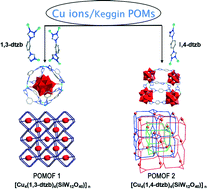Ligand-induced isomerization: from 3D to 2D→3D POMOFs constructed from silicotungstate anions, Cu(i) and 1,n-di(4H-1,2,4-triazol-4-yl)benzene (n = 3, 4) ligands†
Abstract
Two novel POMOFs, [Cu4(1,3-dtzb)4(SiW12O40)]n (1) and [Cu4(1,4-dtzb)4(SiW12O40)]n (2), based on Keggin-type polyoxometalates have been hydrothermally synthesized by altering organic ligands {1,n-di(4H-1,2,4-triazol-4-yl)benzene: n = 3 (1,3-dtzb) and 4 (1,4-dtzb)}. In POMOF 1 constructed from the V-shaped 1,3-dtzb meta-ligand, the ligands link the Cu(I) ions to form a 20-member metallomacrocycle with [Cu2(1,3-dtzb)2] as the SBU, four of which assemble into a cage-like [Cu2(1,3-dtzb)2]4 motif to embed the POM anion, resulting in a 3D POMOF showing a new type of topological structure with a point symbol of {4·53·72}{52·8}. However, when the ligand is changed to the 1,4-dtzb straight para-ligand, POMOF 2 with a different structure is achieved. The ligands link the Cu(I) ions into a basic 3,3-connected net, and then the POM anions insert into the space between two adjacent nets to form a POM-pillared double-layer framework. The large cavities of the POM-pillared double layers allow the occurrence of an interpenetrated 2D→3D framework. The cyclic voltammetric behavior and photocatalytic properties of POMOFs 1 and 2 were also investigated.


 Please wait while we load your content...
Please wait while we load your content...